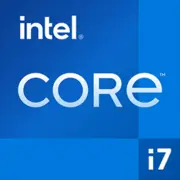Intel Core i7-12700

Intel Core i7-12700: Panoramica e guida alla scelta per assemblare un PC nel 2025
Marzo 2025
Caratteristiche principali: Architettura Alder Lake e caratteristiche chiave
Il processore Intel Core i7-12700, lanciato alla fine del 2021, rimane attuale nel 2025 grazie all'architettura ibrida Alder Lake. Combina 12 core (8 Performance-cores e 4 Efficient-cores) e 20 thread, offrendo un buon equilibrio tra multitasking ed efficienza energetica.
- Processo tecnologico Intel 7 (10 nm Enhanced SuperFin): Consente di ridurre il consumo energetico (TDP 65 W) senza compromettere le prestazioni.
- Frequenze: I P-cores operano a una frequenza base di 2.1 GHz con overclock turbo fino a 4.8 GHz, mentre gli E-cores fino a 3.6 GHz.
- Cache: 25 MB di cache L3 accelerano l'elaborazione dei dati nei giochi e nelle applicazioni professionali.
- Grafica integrata: UHD Graphics 770 (frequenza base 300 MHz, massima 1.5 GHz) è adatta per compiti d’ufficio e giochi leggeri.
- Prestazioni: In Geekbench 6, il processore ottiene 2249 punti in single-thread e 10507 in multi-thread, superando molti modelli di precedente generazione.
Caratteristiche chiave:
- Supporto per PCIe 5.0 e Thunderbolt 4 (tramite chipset).
- Tecnologie Intel Thread Director per ottimizzare il carico sui core ibridi in Windows 11.
- Efficienza energetica: anche sotto carico, il consumo raramente supera i 120 W.
Schede madri compatibili: Socket e chipset
Il processore utilizza il socket LGA 1700, supportato dai chipset delle serie 600 e 700:
- Z790/Z690: Per appassionati. Supporto overclock, PCIe 5.0, DDR5. Esempi: ASUS ROG Strix Z790-E (circa $350).
- B660/H670: Scelta ottimale per la maggior parte. B660 (da $120) non supporta overclock, ma funziona con DDR4/DDR5.
- H610: Opzione budget (da $90) con limitazioni a PCIe 4.0 e DDR4.
Consiglio: Se non pianifichi di fare overclock, scegli B660 con DDR4 — questo ti farà risparmiare $100-150 sulla memoria. Per un futuro upgrade (ad esempio, a Core i9-13900K) è meglio optare per Z790.
Supporto della memoria: DDR4 vs DDR5
Il Core i7-12700 funziona con entrambi i tipi di memoria, ma la scelta dipende dal budget e dai requisiti:
- DDR4-3200: Opzione accessibile (16 GB — $50). Adatto per giochi e attività quotidiane.
- DDR5-4800+: Più costoso (16 GB — $90), ma offre un incremento nel rendering e nelle applicazioni "pesanti".
Esempio pratico: Nei test di Cyberpunk 2077, la differenza tra DDR4 e DDR5 è di 5-7 FPS, ma in Blender il rendering è accelerato del 12-15%.
Alimentatore: Calcolo della potenza
Con un TDP di 65 W, il processore influisce moderatamente sul consumo energetico del sistema. Raccomandazioni:
- Senza scheda video dedicata: Un alimentatore da 300-400 W è sufficiente (ad esempio, be quiet! Pure Power 11 400W — $60).
- Con scheda video come RTX 4070: Alimentatore da 650-750 W (Corsair RM750e — $110).
- Per GPU top di gamma (RTX 4090): 850+ W e cavo PCIe 5.0.
Importante: Non risparmiare sull'alimentatore — un'alimentazione instabile può danneggiare i componenti.
Pro e contro del Core i7-12700
Pro:
- Alta prestazione multi-thread per rendering e streaming.
- Basso consumo energetico in idle.
- Grafica integrata — una salvezza in assenza di scheda video dedicata.
Contro:
- Riscaldamento dei P-cores fino a 85°C sotto carico (richiede un buon dissipatore).
- Overclock limitato (solo su chipset Z).
- Il DDR5 è più costoso, ma non sempre giustificato per i giochi.
Scenari di utilizzo
- Gioco: Accoppiato con RTX 4070 Ti, il processore produce 144+ FPS a 1440p (esempio: Hogwarts Legacy — 132 FPS).
- Attività lavorative: Montaggio video in Premiere Pro (il timeline 4K è renderizzato in 18 minuti), programmazione in Docker.
- Multimedia: Streaming su OBS senza lag grazie ai 20 thread.
Confronto con i concorrenti
- AMD Ryzen 7 7700X: Costa $320 (i7-12700 — $280). Migliore in compiti single-thread (Geekbench 6 Single Core — 2450), ma più costoso.
- Intel Core i5-13600K: A $260 offre 14 core, ma meno stabile nelle applicazioni professionali.
Conclusione: L'i7-12700 vince in termini di rapporto prezzo/prestazioni per scenari multi-thread.
Consigli per l'assemblaggio
1. Dissipazione: Scegli un dissipatore a torre (DeepCool AK620 — $60) o un sistema di raffreddamento a liquido (NZXT Kraken X53 — $130).
2. Memoria: Per DDR5 prendi moduli con dissipatori (G.Skill Trident Z5).
3. Scheda madre: Controlla il supporto per PCIe 5.0 se pianifichi un upgrade della scheda video.
4. Aggiornamento BIOS: Per i chipset della serie 600 potrebbe essere necessario un aggiornamento per funzionare con Windows 12.
Conclusione finale: A chi si adatta il Core i7-12700?
Questo processore è ideale per:
- Giocatori, che desiderano giocare a 2K/4K senza colli di bottiglia.
- Professionisti: montatori video, designer 3D, ingegneri.
- Appassionati, che assemblano un PC con una visione a 3-5 anni.
Nel 2025, l'i7-12700 rimane una scelta vantaggiosa grazie a un prezzo di $250-300 e alla sua versatilità. Perde rispetto ai nuovi Ryzen 8000 in carichi single-thread, ma compensa con stabilità e basso TDP. Se hai bisogno di un processore affidabile "per ogni evenienza", questo è il tuo opzione.
Di base
Specifiche della CPU
Specifiche della memoria
Specifiche della GPU
Varie
Classifiche
Rispetto ad altre CPU
Confronti tra CPU correlati
Condividi sui social media
Oppure linkaci
<a href="https://cputronic.com/it/cpu/intel-core-i7-12700" target="_blank">Intel Core i7-12700</a>

